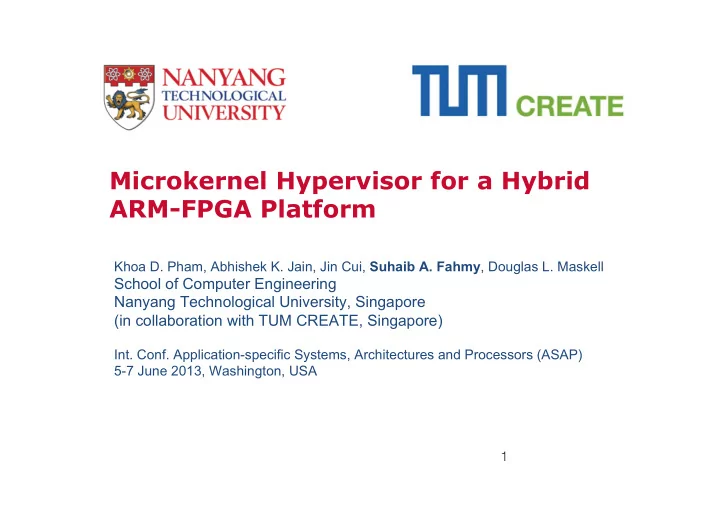

Microkernel Hypervisor for a Hybrid ARM-FPGA Platform Khoa D. Pham, Abhishek K. Jain, Jin Cui, Suhaib A. Fahmy , Douglas L. Maskell School of Computer Engineering Nanyang Technological University, Singapore (in collaboration with TUM CREATE, Singapore) Int. Conf. Application-specific Systems, Architectures and Processors (ASAP) 5-7 June 2013, Washington, USA 1
Motivation • Increased computing in vehicles through increased number of compute nodes • Isolation essential for safety à complex network • Desire to consolidate compute on fewer nodes • New hybrid architectures provide ideal platform ECU ECU ECU 2
Hybrid Platform • New hybrid FPGAs with ARM cores provide: – Processor-first view of device, independently functional – A core of comparable performance to existing SoCs – High throughput between core and fabric • Offers us the software-programming view but with hardware performance • How can we take advantage of hardware isolation while still offering a software interface? • This is still a key difficulty in design for these hybrid architectures (design time) 3
4 Courtesy Xilinx
Proposed Approach • A hypervisor to virtualise access to all resources – Software, including bare metal applications, full OS, realtime OS – Hardware: • Static accelerators • Virtual fabric for ease of programming • Partially reconfigurable regions • Task management across resources, with low latency communication and context switch 5
Proposed Approach 6
Hardware Support • Communication: – Zynq provides high performance AXI interface between processor and fabric • Context Frame Buffer – Hardware tasks can be decomposed into multiple contexts – Storing contexts off-chip is more scalable – A buffer in Block RAMs makes access faster • Intermediate Fabric – A way of using the logic fabric at a higher layer of abstraction – Communicate through dual ported Block RAMs 7
CPU CFB Context Registers Configuration Data DMA Control PCAP AXI Interconnection Monitor Status 3 IF or DPR Main Memory Dual Port BRAMs attached on AXI DMA Controller in PS 2 1 HP AXI Master AXI Slave CFB (DMA Master) Master Controller Sequencer Hardware Support 3 8
Porting the Hypervisor The CODEZERO hypervisor from B-Labs was modified: • Rewriting drivers for the Zynq ARM (PCAP, timers, interrupt controller, etc.) • FPGA initialisation (clocks, pin mapping, interrupts) • Hardware task management and scheduling • DMA transfer support • All scheduling and management is managed by the hypervisor 9
Context Sequencer • Manages hardware tasks • Loads context frames (parts of a task) • Memory mapped register interface in fabric • Control register to control how many frames and base address for configuration • Status register indicates hardware task status like completion 10
Context Sequencer Start_bit=0 IDLE Start_bit=1 Task Start CONTEXT_START CONFIGURE EXECUTE Context Start Counter != Num_Context RESET IF/DPR CONTEXT_FINISH Context Finish Counter=Num_Context DONE Task finished 11
Intermediate Fabric • Allows more coarse grained use of FPGA logic fabric – Simple compilation – Reduced configuration time – Predictable timing 12
Intermediate Fabric • A simple fabric with DSP block-based processing elements • Configurable nearest neighbour connections • Map two applications: – Matrix multiplication – FIR filter • Fabric not optimised, but proof of concept 13
Hardware task management • Non-preemptive switching – Hypervisor mutex mechanism used to block access to hardware – On completion of a context, lock is released to allow switch – No need for context save and restore – Minimal modifications to hypervisor required • Preemptive switching – Must be able to store and load contexts – Modifications to user thread control block and context switch – Can provide faster response time at cost of overhead 14
Case Study • Proof of concept with three containers: – Real-time OS container with 14 software tasks – A bare metal application that runs a hardware FIR filter task – A bare metal application that runs a hardware matrix multiplication task – The hardware tasks use the same intermediate fabric • FIR filter uses single context frame • Matrix mult requires 3 context frames 15
Case Study Task 1 Task 14 … (SW) (SW) Matrix FIR application uC/OS-II multiplication (HW) (HW) Microkernel based Hypervisor CPU FPGA 16
Case Study • Context switch time: Clock cycles (time) Non-preemptive Preemptive T lock (no contention) 214 (0.32 µ s) NA T lock (with contention) 7738 (11.6 µ s) 3264 (4.9 µ s) 3140 (4.7 µ s) T C 0 switch • Configuration and response times: Clock cycles Non-preemptive Preemptive (time) FIR MM FIR MM T conf 2150 (3.2 µ s) 3144 (4.7 µ s) 3392(5.1 µ s) 5378 (8.1 µ s) (8.5 µ s-19.7 µ s) (9.9 µ s-20.3 µ s) (9.8 µ s) (12.8 µ s) T hw resp 17
Future Work • Porting Linux to be para-virtualised on top of CODEZERO • A detailed comparison with hardware managed by Linux threads on the same hypervisor • Direct support for partial reconfiguration • Improved intermediate fabric • Optimisation of communication between hypervisor, hardware, and software tasks 18
Recommend
More recommend